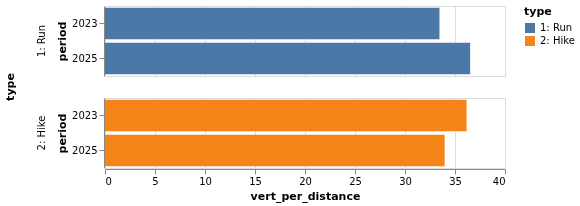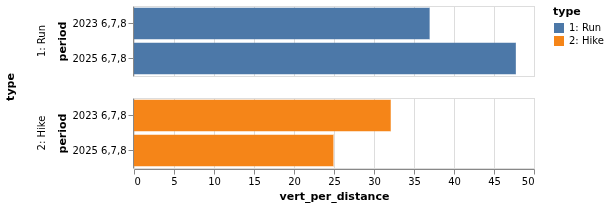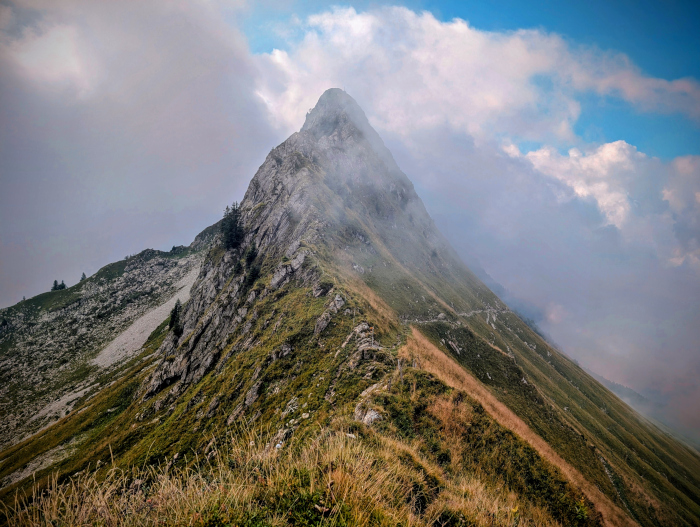24. August 2025
Swiss Peaks 170, The Days Before
 Less than two weeks to go to Swiss Peaks 170. Time to reinforce the idea that the training is done except for the taper. Time to reinforce the idea that I am prepared, no more, but also importantly, no less.
Less than two weeks to go to Swiss Peaks 170. Time to reinforce the idea that the training is done except for the taper. Time to reinforce the idea that I am prepared, no more, but also importantly, no less.
The taper weeks have arrived. The work has been done. Time to shed the fatigue so deliberately induced through weeks and months of training. My body notices. As the volume of work reduces, the signal to the body is clear. Time to recover. I feel tired, which at first seems odd. Why feel tired when doing less? But that’s because my body noticed. Time to recover. It takes what it needs. It is a good thing.
How prepared am I? That is unclear. Why unclear? Until the fatigue disappears, I just will not know. Once the fatigue clears, I am already at the start line. At the Grande Dixence Dam in Valais, Switzerland. Europe’s tallest. The world’s tallest gravity dam. The point where an enormous challenge begins for me: 168 km and 11’000 m of elevation gain. Until then I have to put my trust into the process. As so often in training. As so often in life.
There is nothing I can change about the training over the past months. Why bother looking back then? It is a rationale voice that puts a floor underneath doubts or negative self-talk. Nothing can take that training away, and at least some of that training must surely have been effective!
To get a sense of the work that I put in, I compared the period of (2023-01-01, 2023-08-23; alias “2023”) against the period of (2025-01-01, 2025-08-23; alias “2025”). In 2023, I prepared for the Swiss Peaks 360, so that should provide a good baseline for comparison. The modalities of running and hiking overlap on steep uphills and steep downhills. The race includes plenty of such terrain. Thus, it makes sense to look at activities I tagged as either running or as hiking.
What did I find? Let’s start with time on feet on my runs. In 2025, I spent 263h on my feet. That’s about +10% more than in 2023, but is roughly the same when comparing hiking and running combined.

A similar picture emerges when it comes to distance overed: +4% distance run over the 2025 period. No big difference, quantitatively.

Total elevation gain increased by +13% in the 2025 period for “running” activities, and by +8% for “running” and “hiking” combined. That’s quite a bit. Of course, this has to be put into context: as I understand it, it is more important to do training at similar gradients as encountered during the race, rather than just accumulating vertical gain (think: by “climbing up ladders”). Anyhow, this looks promising. Or at the very least, not concerning at all.

The “vert per distance” (m / km) measures how many meters I climbed for every kilometer run / hiked. When I look at the running (the bulk of the volume), the vert per distance increased by +10% in the 2025 period. At least in this aspect, this year’s training appears to be more specific with respect to the race demands (65 m/km).

Assuming that the work done in the months closer to the race carry more weight with respect to race performance, I can do a similar analysis for the months of June, July, and most of August (alias “6, 7, 8”).
The picture here is pretty clear: a +37% increase in elevation gain for running activities (2025 6,7,8).

At a similar distance covered, I have put in more work at gradients that I will encounter in the race: 48 m/km (2025 6,7,8) compared to 37 m/km (2023 6,7,8). That is no accident: the Koop AI has programmed my training in this direction. Where I live, on the Swiss Plateau, I had to go up and down a hill repeatedly in order to make this happen.

Summary? Purely looking at the data suggests I can look at the Swiss Peaks 170 in 2025 with at least as much confidence as in 2023 when lining up for the Swiss Peaks 360. But also not expect wonders.
What else was different in 2025 compared to 2023? Let’s drill into the data. I plotted the 32 weeks of training in 2023 against the 32 weeks of training in 2025, including only running activities. Each bubble represents a day. The size represents the distance covered, the shade the elevation gain.

Looking at the above chart, a pattern is evident: I trained more frequently, but over shorter distances in 2025. I did fewer “really big days” on the weekends in 2025 compared to 2023, yet the overall training volume in 2025 exceeded that from 2023. I believe that the more regular training can be explained: I am following the KoopAI training program in 2025, which helps me to consistently get out of the door, have fun, and get the job done. On another note, light injury led to a two-week training gap in 2025, but it did not affect the weeks that followed in comparison.

Numbers are not everything. There is a qualitative aspect to training (terrain, skills), and there are aspects that are very important yet difficult to quantify (recovery). My feeling, though, is that I am decently prepared. I feel motivated, I am excited. I feel that the training in the past ten weeks since the Scenic Trail race was productive. The data agrees: ten weeks of consistent training averaging at 10.5 h moving time, 70 km distance, 3400 m elevation gain, 48 m/km vert per distance.
The challenge remains as large as it was before. The ascents as steep as they were before. The cols remain as high as they were before. The descents as technical as they were before. None of the preparation changes that. Out of my control. Most of the training has been done. Out of my control, now. What is in my control, is to complete the taper period, and make the most out of this opportunity: moving through this spectacular landscape during day and night, within the setting of a race, supported by awesome staff. When do you get such an opportunity? I get to do this, and I am uncomfortably excited.